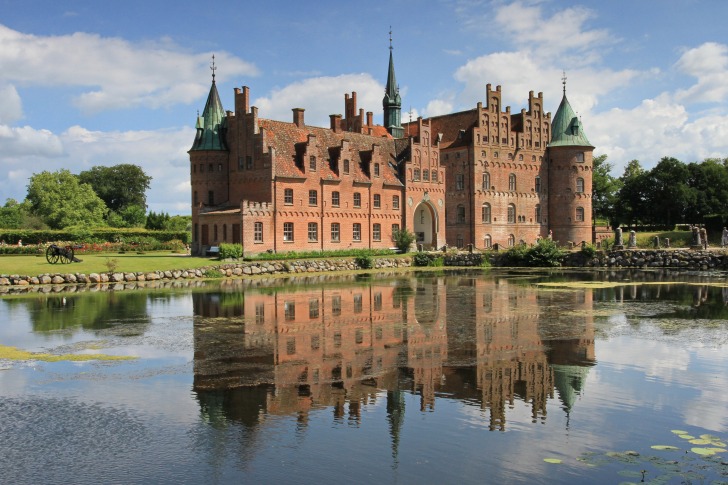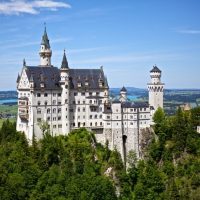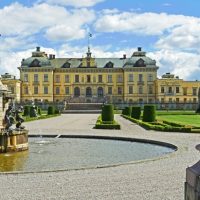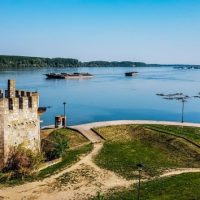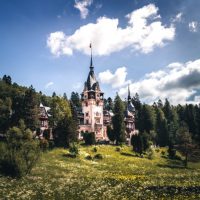First founded in the 10th century, the small Scandinavian country of Denmark has a long and rich history.
Since that time, many royal families have ruled the region.
Each royal family made its mark in the history books and erected numerous castles across the country.
Today, many of Denmark’s historic castles are still standing.
Nestled along the country’s coastline, on inlets and smaller islands, and in the heart of Denmark’s biggest cities, these castles offer visitors a glimpse into what life was like as royalty.
From its lush landscapes to historic buildings, Denmark has something to offer every member of your family.
Its central location makes it a popular destination for European travelers.
If you enjoy exploring the outdoors and learning about the history and ancient culture of a region, Denmark should be at the top of your bucket list.
Each castle has its own charm and represents the traditions and culture of the area.
11 Most Beautiful Castles in Denmark
Below is a list of the top castles you won’t want to miss.
1. Egeskov Castle
Situated in the breathtaking region of Southern Funen, Egeskov Castle is one of the most famous castles in Europe.
Dating back over 460 years, this castle has a long and tumultuous history.
Its thick double walls and meticulously preserved moat show that the castle was originally built for defense in battle.
The battle is just one facet of Egeskov Castle’s history.
Built in the middle of a small lake, the castle is now a place of peace.
Outside, visitors take in Egeskov’s impressive gardens. Before venturing inside, be sure to check out the kids’ activity area and stop in for a snack at “Great Grandfather’s Playground.”
Stepping inside this exquisite castle is like stepping back in time.
The ground floor, aptly named the Hunting Room, features ancient hunting trophies.
The castle’s first floor, which has a banquet hall and five other impressive rooms, is filled with furniture and trophies owned by Denmark’s beloved kings and queens.
Interspersed throughout are the castle’s 2,000 window panes, which will take your breath away.
2. Frederiksborg Castle
Less than an hour’s drive from Copenhagen is Frederiksborg Castle, built by Danish King Christian IV.
The castle, located in the city of Hillerød, is home to Denmark’s Museum of National History.
Furniture, portraits, and other antiques fill the castle’s rooms, offering visitors a look at Denmark’s culture and history from the late Middle Ages to the present.
Dubbed Denmark’s Versailles, this Renaissance castle is surrounded by Baroque gardens that will take your breath away.
Don’t forget to take a stroll through Frederiksborg Castle’s English Landscape Park while you’re there.
As you step into this magical space, you’ll see why the park is a main attraction for anyone visiting the area.
3. Rosenborg Castle
Originally built as a summer home, Rosenborg Castle is another one of King Christian IV’s architectural masterpieces.
The castle, located in Copenhagen, took twenty-eight years and four stages to complete.
Christian IV’s most momentous project was finally completed in 1633.
Rosenborg Castle’s doors were opened to the public in 1838 and continue to be one of the region’s most visited attractions.
The Great Hall is home to Denmark’s coronation thrones, crowns, and crown jewels.
Three life-size silver lions stand guard, protecting these historical artifacts.
This 400-year-old castle is located in Copenhagen’s most popular park, The King’s Garden.
Filled with historical sculptures, rose gardens, and a pavilion, this Renaissance-style park is a favorite among locals and travelers alike.
4. Kronborg Castle
Just a 30-minute drive north of Copenhagen is Kronborg Castle, the most famous historic castle in Denmark.
Construction on the castle, built by King Frederik II, began in 1574 and lasted until 1585.
The castle is now one of the most popular UNESCO World Heritage Sites in the Nordic Region.
Built on the tip of Zealand Island in the Øresund Strait, Kronborg Castle was built to fortify the coastal region and control trading vessels entering the Baltic Sea.
Ships were required to pay a gold tax, called “the Sound Dues,” to the Danish King.
Today, visitors can learn more about how this Renaissance castle was used.
Despite its long and arduous history, Kronborg is most famous for being the inspiration behind William Shakespeare’s Hamlet.
The castle, often referred to as “Hamlet’s Castle,” hosts live performances of Shakespeare’s most renowned plays.
5. Christiansborg Palace
Located on the isle of Slotsholmen in Copenhagen is Christiansborg Palace.
First constructed in 1167, this castle has been Denmark’s center of power for over 800 years.
Christiansborg served as the Royal Palace until 1794 and is where the Danish kings and queens held audiences, signed laws, and entertained royal guests.
While the palace is still used for royal events, it’s now primarily used as a government building.
As the seat of the Supreme Court of Denmark, the Danish Parliament, and the Danish Prime Minister’s Office, Christianborg Palace is the only building in the world to host all three branches of a country’s government.
In 1794 and 1884, the palace was forced to rebuild due to serious fire damage.
Today, visitors can enjoy three different eras of Danish architecture as they meander through the stately rooms and Great Hall.
While you’re there, be sure to check out the Roman-inspired Palance Chapel and the Baroque-style Royal Stables, which houses the 24-carat Golden State Coach.
6. Koldinghus Castle
Located in the south-central region of the Jutland Peninsula, Koldinghus Castle has played a vital role in Danish history since the 13th century.
Over the course of its life, the castle has served as a fortress, a site for wartime negotiations, and royal residency.
Today, Koldinghus is an award-winning museum.
Its exhibits and collections take visitors back in time, where they can learn about Danish culture and history.
7. Amalienborg Palace
As home to Denmark’s Royal Family, Amalienborg Palace is the most popular attraction in Copenhagen.
Built in the 1750s, Amalienborg Palace features four identical palaces built around an octagonal courtyard.
Four noble families lived in the palaces until the fire of 1794.
While the main palace isn’t open to the public, there’s much to see during your visit to Amalienborg Palace.
The Danish Royal Guard, called Den Kongelige Livgarde, marches to Amalienborg each day.
The march starts at 11:30 and ends with the changing of the guard at noon.
While you’re in the palace square, be sure to check out the statue of King Frederik V, one of the most famous equestrian statues in the world.
8. Marselisborg Palace
Marselisborg Palace, located in Aarhus, has served as the summer residence for Queen Margreth II since the late 1960s.
Built in 1899, the palace was a wedding present to the Crown Prince Christian from the Danish.
The Palace’s most popular feature is Palace Park.
The park, which is only open to the public when the Royal Family is staying elsewhere, features the Queen’s rose garden, art pieces, and sculptures.
9. Fredensborg Palace
Often referred to as the Palace of Peace, the Baroque-style castle of Fredensborg Palace was built to commemorate the ending of the war in 1722.
Over the years, the Royal Family has used the palace as their primary residence and has hosted many important galas and celebrations.
Fredensborg Palace has hosted many state leaders throughout its history.
During their visit, each leader was honored to uphold the long-standing tradition of inscribing their names in a palace window with a diamond pen.
10. Dragsholm Castle
First built in 1215 by the Bishop of Roskilde, Dragsholm Castle is one of the oldest buildings in Denmark.
While the castle has gone through several restorations over the years, it still stands today as a reminder of Denmark’s long and arduous history.
Today, visitors can explore the halls of this beautiful castle, which has its original moat.
The castle now serves as a hotel, which many claims to be haunted.
If you decide to stay on-site, be sure to look out for the ghost of the gray and white lady, who still roams the halls at night.
11. Frederiksberg Palace
Nestled at the top of Valby Hill lies the centuries-old Frederiksberg Palace and Garden.
The palace, which dates back to the early 1700s, was inspired by Italian architecture that was famous at that time.
Crown Prince Frederick IV was responsible for proposing the idea of building a summer palace in the style of Italian architecture of the day.
His father, Christian V gave permission, and the summer palace was built and completed in 1703.
Current attractions include the park in Frederiksburg Gardens, which was part of the original palace design.
The garden has been redesigned over the years, but remains an impressive sight.
The palace also features a baroque-styled chapel, and is able to be viewed by the public.
Denmark Safety Overview
READ THE FULL REPORT: Denmark Safety Review
Safety Index: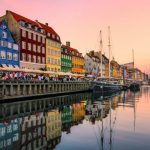
- OVERALL RISK: LOW
- TRANSPORT & TAXIS RISK: LOW
- PICKPOCKETS RISK: LOW
- NATURAL DISASTERS RISK: LOW
- MUGGING RISK: LOW
- TERRORISM RISK: LOW
- SCAMS RISK: LOW
- WOMEN TRAVELERS RISK: LOW
Frequently Asked Questions
What is the oldest castle in Denmark?
At over 500 years old, Rosenholm Castle is the oldest family-owned castle in Denmark.
The castle is often referred to as the Buckingham Palace of Copenhagen.
Which palace is the best to visit in Copenhagen?
Amalienborg Palace is the most popular attraction in Copenhagen.
Here, travelers can witness the changing of the guard and immerse themselves in Danish history.
What is the most famous castle in Denmark?
As the largest castle in Denmark, Frederiksborg Castle is also the most famous.
Visitors are immersed in the country’s history as they explore the grounds and soak in the art, architecture, and gardens.
What is the biggest castle in Denmark?
Frederiksborg Castle is the largest castle in the country, often referred to as Denmark’s Versailles.
The castle features a large baroque garden and serves as Denmark’s Museum of National History.
